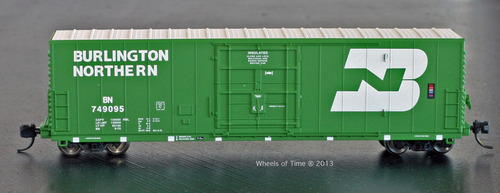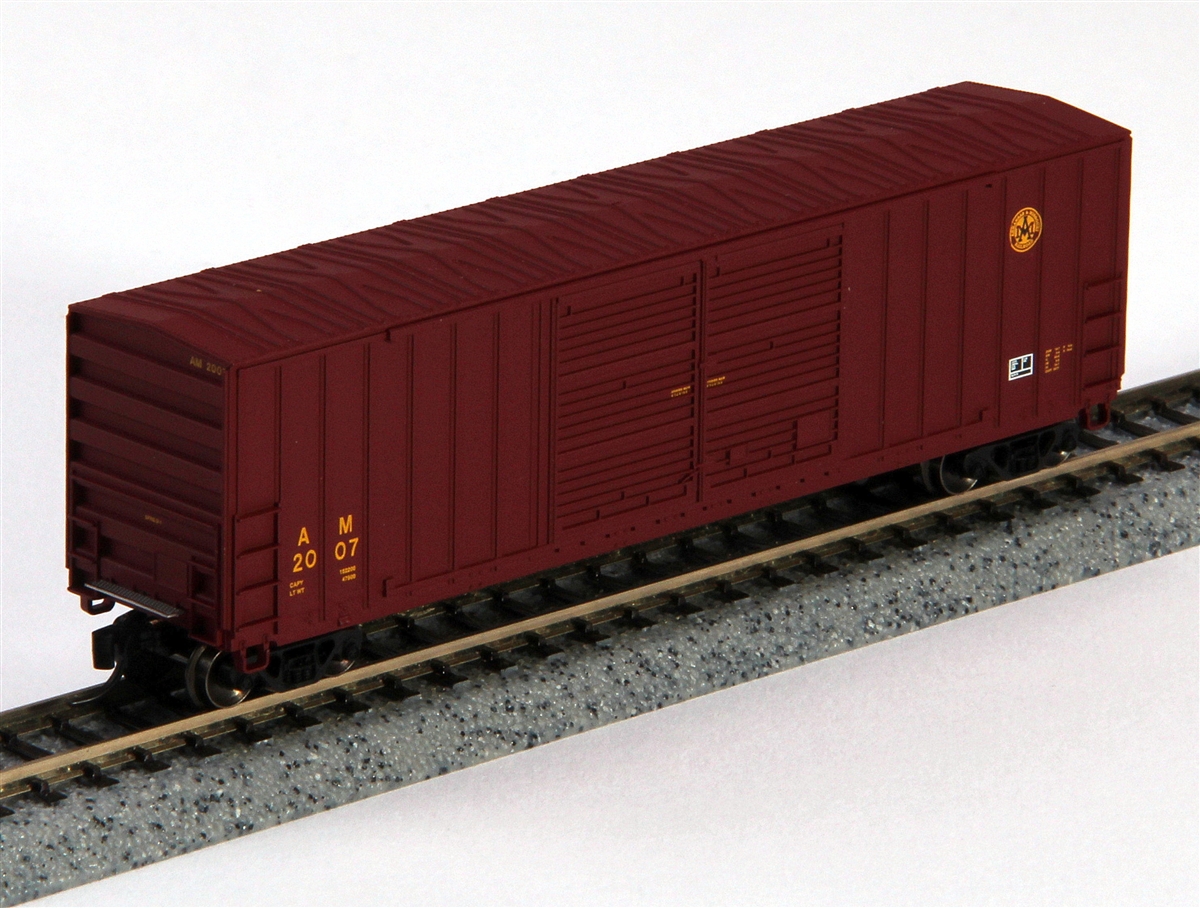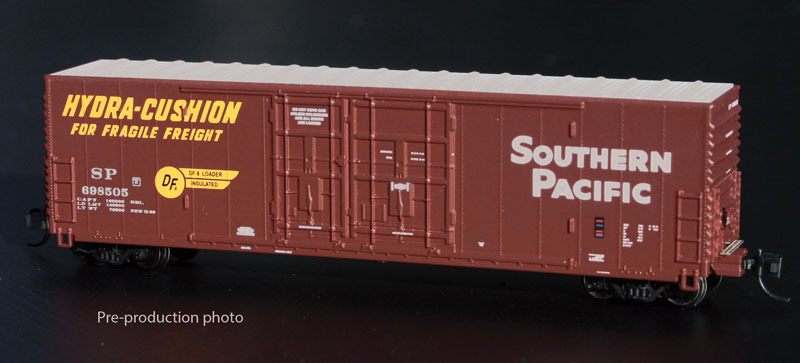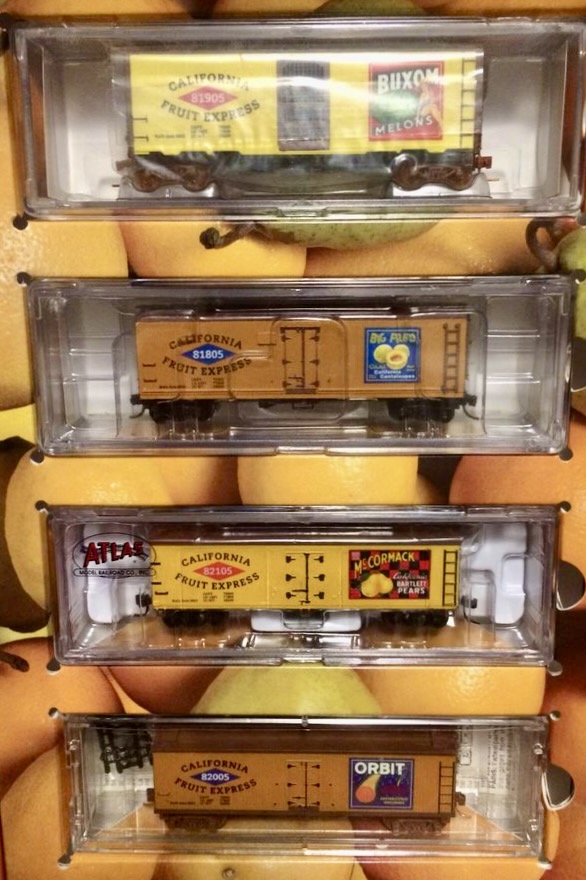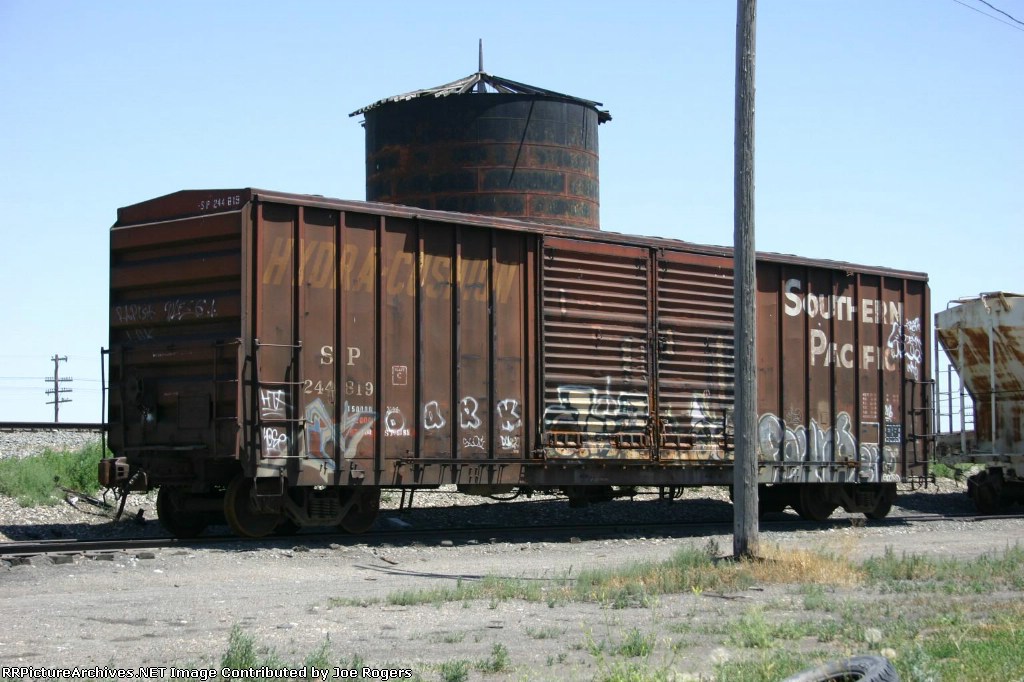Model Information: These models were introduced by Fox Valley in 2007. The model is made in China and clearly marked as such on the bottom. It is a model of the FMC (Food Machinery Co) 5283 c.f. Double Door boxcar. It features Micro-Trains body-mount couplers. The wheels are the typical high-quality blackened metal variety tat Fox Valley is famous for. The print quality is excellent. The underframe is a little simple, but at least it is a solid step up from some of the body styles they acquired from other manufacturers. It has some very nice details in the separately applied etched-metal platforms on each end. The ladders and placards, however, are molded in. This helps keep the cost down but never looks as nice as when these are detail parts.
Prototype History: In the 1970's with the growth of the Per Diem business model, FMC produced a series of 50 foot box cars in different configurations. The double-sliding-door configuration is one common variation that was used by many different railroads. FMC provided a large number of box cars for SSI, Itel, Brae, and Rex. Due to the economic recession which began in late 1979, most these cars were soon transferred to other railroads one or more times. By the 1990s, most had been acquired by GE. They continued to change hands nearly every time a lease expired, or they were rebuilt. The renumberings of GE owned cars are often very complex, but some of the most commonly seen reporting marks are EEC, HS, and SRN.
The XM-class, 50-foot, double door, 5283 cubic foot capacity boxcars, were one of the later variations in this series. Records show that some (but likely not all) were built between May and June 1977 by FMC in Portland, OR.
The XM-class, 50-foot, double door, 5283 cubic foot capacity boxcars, were one of the later variations in this series. Records show that some (but likely not all) were built between May and June 1977 by FMC in Portland, OR.
Road Name History: The DM&E launched in 1986 as a spin-off of Chicago & North Western. The mainline ran from Winona, Minnesota (where there are Mississippi River docks) west to Rochester, Mankato, then onto Pierre and Rapid City, South Dakota. At that point the line split with one leg headed west to Colony, Wyoming, and the other leg headed south to Crawford, Nebraska. There were also a few other branchlines. Total mileage was 965 miles (putting it between Chicago & Eastern Illinois and Montana Rail Link in relative size.)
Operations began with 39 locomotives, mostly rebuilt SD9’s of Milwaukee Road heritage. Eventually DM&E dumped these first generation engines and in later years had a fleet of 69 rebuilt SD40-2’s, GP40-2’s, GP38-2’s, and a few one-offs. They also had about 5,000 freight cars, mostly grain hoppers.
In 1997, DM&E announced their intention to build a line to the huge coal reserves in Wyoming’s Powder River Basin. The project would have included rebuilding nearly the entire mainline plus building a new (and long) branch to reach the Basin. It would have been the biggest new construction since Great Northern’s Oregon Trunk in 1931. They did receive permission from the government but NIMBY opposition dragged out the start of construction for many years.
In 2008, The Dakota Minnesota & Eastern and sister road Iowa Chicago & Eastern were purchased by Canadian Pacific. After a bit of study, CPR wisely backed away from the Powder River Project.
Operations began with 39 locomotives, mostly rebuilt SD9’s of Milwaukee Road heritage. Eventually DM&E dumped these first generation engines and in later years had a fleet of 69 rebuilt SD40-2’s, GP40-2’s, GP38-2’s, and a few one-offs. They also had about 5,000 freight cars, mostly grain hoppers.
In 1997, DM&E announced their intention to build a line to the huge coal reserves in Wyoming’s Powder River Basin. The project would have included rebuilding nearly the entire mainline plus building a new (and long) branch to reach the Basin. It would have been the biggest new construction since Great Northern’s Oregon Trunk in 1931. They did receive permission from the government but NIMBY opposition dragged out the start of construction for many years.
In 2008, The Dakota Minnesota & Eastern and sister road Iowa Chicago & Eastern were purchased by Canadian Pacific. After a bit of study, CPR wisely backed away from the Powder River Project.
Brand/Importer Information: Fox Valley Models is a small supplier of
model railroad and related products. FVM
started by finding solutions to different
challenges that model railroaders were
faced with. Our first products resulted
from a need to equip custom built
passenger cars with tinted windows made
of an ideal material; thin, flexible, easy to
cut, simple to install, available in multiple
colors and be affordable. We met those
needs and even included a frosted
version for the car's lavatory windows.
Other challenges inspired additional products including wooden grade crossings, trestles and different lineside structures. As our product line expands, input and requests from friends and customers help shape the product selection further.
Future products, under development, include more parts, structures, details and rolling stock. We strive to offer a good quality product at an affordable price.
Other challenges inspired additional products including wooden grade crossings, trestles and different lineside structures. As our product line expands, input and requests from friends and customers help shape the product selection further.
Future products, under development, include more parts, structures, details and rolling stock. We strive to offer a good quality product at an affordable price.
Item created by: CNW400 on 2022-12-06 13:33:29
If you see errors or missing data in this entry, please feel free to log in and edit it. Anyone with a Gmail account can log in instantly.
If you see errors or missing data in this entry, please feel free to log in and edit it. Anyone with a Gmail account can log in instantly.







